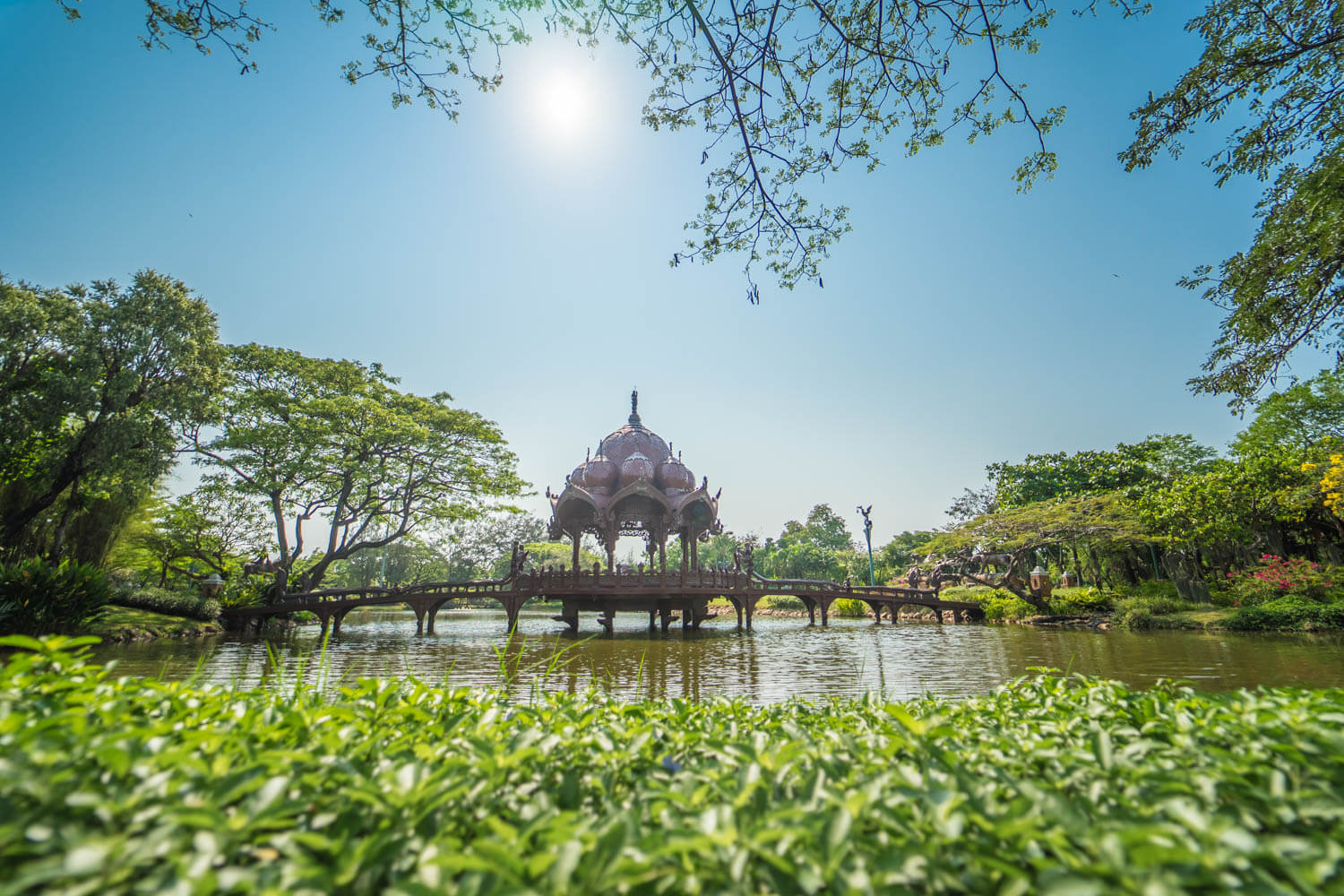The Garden of the Gods (43)
- Information
The splendid Garden of the Gods at Muang Boran has been painstakingly created. It is a collection of contemporary bronze imanges of the various Hindu gods; most of which are often mentioned in Thai classical literature and have been well-known amomg Thai people for centuries.
The bronze statues in the garden include.
1. Vishnu (or Phra Narai) asleep on the back of Naga Ananta, the Naga Serpent King,floating on the middle of the ocean. Laksmi,his consort,sits at his feet holding a whisk.
2. Brahma (or Phra Phrom), the second major deity of Hinduism who is believed to be the creator of the universe, is while Hindu god with 4 face and 8 arms, The sculptor normally cast the statue with only 4 arms. In his hands he carries a walking cane, a spoop (to scpoop off fat globules), a water pot and a book of scriptures.
3. Shiva (or Phra Isvara) was the King of all gods having power over both deities and evil. He is the god of destruction. His closed third eye on his forehead, if opened, will burn everything before his eyes. Shiva is seated on his bull, Nandi. The Goddess,Uma sits before him.
4. Sarasvati (or Surasawadi) is the fair-skinned consort of Brahma. She is considered to be the goddess of learning and the arts. In her hands she carries a lotus bud, a drinking vessel, a book and the vina (harp), a stringed musical instrument of Indian classical miusic.
5. Aditya or Suriya (or Phra Athit), the sun, the god of light, is seated on this chariot of seven skyhorses driven by his ride, Phra Arun
6. Chandra (or Phra Chan), the Moon, is a male deity who rides a chariot drawn by ten horses. His nature is suave and gentle.
7. Angaraka (or Phra Angkhan) rides a water buffalo. He is Mars, the god of war, and also the god of hard-work and conflict.
8. Budha, is an Indian equivalent of Mercury and Woden. He rides an elephant. He is the deity of wisdom, communication and books.
9. Brihaspati (or Pharuhatsabodi) is the heavenly seer who carries a slate and rides a deer. He corresponds to Jupter, tutor of the gods. Thursday, his day, is dedicated to teachers.
10. Sukra, the god who presides over Friday, rides a bull. He is considered one of the heavenly seers as well as a tutor of the gods. He is the deity of wealh and fine art.
11. Sani (or Phra Sao), equivalent to Saturn, with bow and trident in his hands, is considered the god of difficulty. The peple who are born under the influence of Saturn are believed to fall easily nito grive, despair, ad difficulties. He is seated on his vehicle, atiger.
12. Rahu is known as the Nara Graha (Thai: Nophakhro) and features extensively in Indian astrology. In one form, Rahu is halr-human half-ogre who swallows the solar and lunar eclipse respectively. In another form, Rahu is half-human half-snake. He was split in two by Narayana’s chakra, or flying discus, during the churning of the ocean ceremony.
The bronze statues in the garden include.
1. Vishnu (or Phra Narai) asleep on the back of Naga Ananta, the Naga Serpent King,floating on the middle of the ocean. Laksmi,his consort,sits at his feet holding a whisk.
2. Brahma (or Phra Phrom), the second major deity of Hinduism who is believed to be the creator of the universe, is while Hindu god with 4 face and 8 arms, The sculptor normally cast the statue with only 4 arms. In his hands he carries a walking cane, a spoop (to scpoop off fat globules), a water pot and a book of scriptures.
3. Shiva (or Phra Isvara) was the King of all gods having power over both deities and evil. He is the god of destruction. His closed third eye on his forehead, if opened, will burn everything before his eyes. Shiva is seated on his bull, Nandi. The Goddess,Uma sits before him.
4. Sarasvati (or Surasawadi) is the fair-skinned consort of Brahma. She is considered to be the goddess of learning and the arts. In her hands she carries a lotus bud, a drinking vessel, a book and the vina (harp), a stringed musical instrument of Indian classical miusic.
5. Aditya or Suriya (or Phra Athit), the sun, the god of light, is seated on this chariot of seven skyhorses driven by his ride, Phra Arun
6. Chandra (or Phra Chan), the Moon, is a male deity who rides a chariot drawn by ten horses. His nature is suave and gentle.
7. Angaraka (or Phra Angkhan) rides a water buffalo. He is Mars, the god of war, and also the god of hard-work and conflict.
8. Budha, is an Indian equivalent of Mercury and Woden. He rides an elephant. He is the deity of wisdom, communication and books.
9. Brihaspati (or Pharuhatsabodi) is the heavenly seer who carries a slate and rides a deer. He corresponds to Jupter, tutor of the gods. Thursday, his day, is dedicated to teachers.
10. Sukra, the god who presides over Friday, rides a bull. He is considered one of the heavenly seers as well as a tutor of the gods. He is the deity of wealh and fine art.
11. Sani (or Phra Sao), equivalent to Saturn, with bow and trident in his hands, is considered the god of difficulty. The peple who are born under the influence of Saturn are believed to fall easily nito grive, despair, ad difficulties. He is seated on his vehicle, atiger.
12. Rahu is known as the Nara Graha (Thai: Nophakhro) and features extensively in Indian astrology. In one form, Rahu is halr-human half-ogre who swallows the solar and lunar eclipse respectively. In another form, Rahu is half-human half-snake. He was split in two by Narayana’s chakra, or flying discus, during the churning of the ocean ceremony.

























